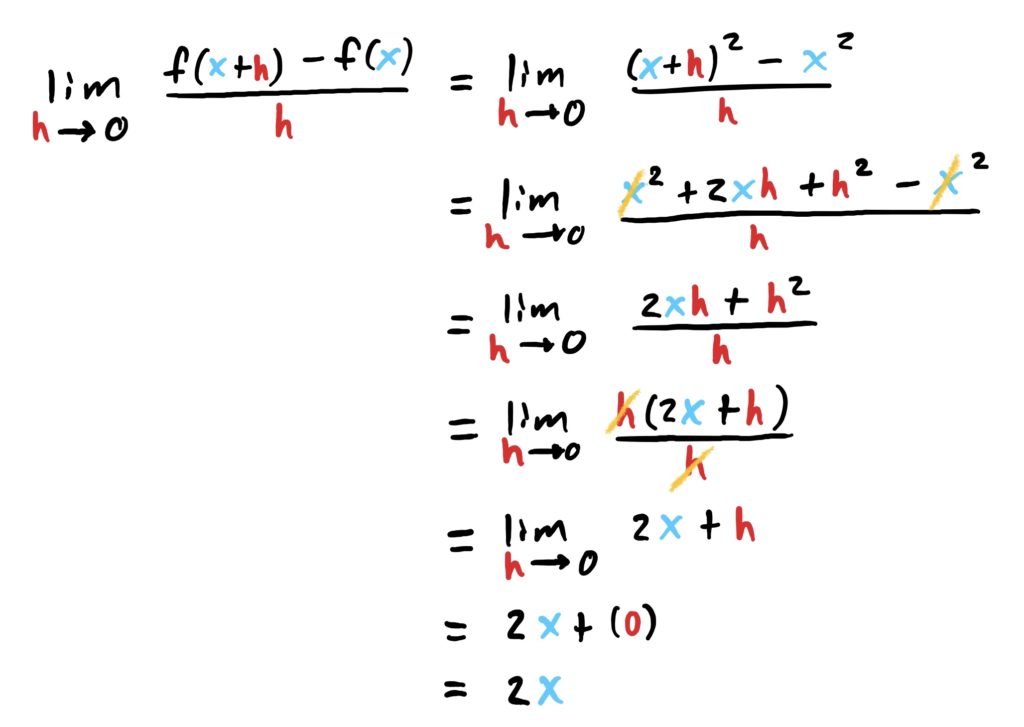The Derivative as a Function
The Derivative as a Function
Recall the definition of the (\(h\)-form of the) derivative at a given \(x\)-value.
Now suppose that we want to use this definition of the derivative to find the derivative of the function \(f(x)=x^2\) at several different \(x\)-values, say \(x=1,2,3\) and \(4\). The process for finding the derivative in each of these four cases is the same; as is the computations required to compute the final answer. This is exhibited in the table below.

Since the process of computing this derivative is basically the same, with the only thing that changes being the \(x\)-values, we could surmise that the process would be the same for any other \(x\)-value we choose. So, since the process is the same regardless of the \(x\)-value, why don’t we simply use a “placeholder symbol” for our \(x\)-value and carry out the process as usual. Let’s call this placeholder (for lack of more appropriate options) “\(x\).” Then the derivative at \(x\) is computed as:

Since \(x\) was a placeholder for any \(x\)-value we wanted to find the derivative at, and given that everything above is equal, we essentially have a formula that will tell us the derivative of \(f(x)=x^2\) no matter what \(x\) is. You can confirm this by plugging \(x=1,2,3,4\) into the formula \(f'(x)=2x\) and compare with the derivatives in the table we built earlier to see that this formula works.
In general, this idea allows us to build a formula that gives us the slope (or instantaneous rate of change) of a function at any \(x\)-value we like.
Try some of the examples below for finding the derivative of various functions!
Find the derivative of the following functions
$$f'(x)=\lim_{h\rightarrow 0} \frac{f(x+h)-f(c)}{h}$$
- Compute \(f(x+h)\) first by plugging the expression \((x+h)\) into \(f\)
- Compute and simplify \(f(x+h)-f(x)\) using the answer to the previous step
- Compute and simplify \(\frac{f(x+h)-f(x)}{h}\) using the answer to the previous step
- Take the limit \(\lim_{h\rightarrow 0}\) of the answer to the above.
\(f'(x)=3\)
$$f'(x)=\lim_{h\rightarrow 0} \frac{f(x+h)-f(c)}{h}$$
- Compute \(f(x+h)\) first by plugging the expression \((x+h)\) into \(f\)
- Compute and simplify \(f(x+h)-f(x)\) using the answer to the previous step
- Compute and simplify \(\frac{f(x+h)-f(x)}{h}\) using the answer to the previous step
- Take the limit \(\lim_{h\rightarrow 0}\) of the answer to the above.
\(f'(x)=5\)
$$f'(x)=\lim_{h\rightarrow 0} \frac{f(x+h)-f(c)}{h}$$
- Compute \(f(x+h)\) first by plugging the expression \((x+h)\) into \(f\)
- Compute and simplify \(f(x+h)-f(x)\) using the answer to the previous step
- Compute and simplify \(\frac{f(x+h)-f(x)}{h}\) using the answer to the previous step
- Take the limit \(\lim_{h\rightarrow 0}\) of the answer to the above.
\(f'(x)=m\). Keep in mind that the derivative is a “slope-producing formula,” and that for a line in the form \(y=mx+b\) the slope is \(m\), which matches our derivative. So derivatives do what they’re supposed to.
$$f'(x)=\lim_{h\rightarrow 0} \frac{f(x+h)-f(c)}{h}$$
- Compute \(f(x+h)\) first by plugging the expression \((x+h)\) into \(f\)
- Compute and simplify \(f(x+h)-f(x)\) using the answer to the previous step
- Compute and simplify \(\frac{f(x+h)-f(x)}{h}\) using the answer to the previous step
- Take the limit \(\lim_{h\rightarrow 0}\) of the answer to the above.
\(f'(x)=6x\), and so
\(f'(1)=6\), \(f'(2)=12\)
$$f'(x)=\lim_{h\rightarrow 0} \frac{f(x+h)-f(c)}{h}$$
- Compute \(f(x+h)\) first by plugging the expression \((x+h)\) into \(f\)
- Compute and simplify \(f(x+h)-f(x)\) using the answer to the previous step
- Compute and simplify \(\frac{f(x+h)-f(x)}{h}\) using the answer to the previous step
- Take the limit \(\lim_{h\rightarrow 0}\) of the answer to the above.
\(g'(x)=-4x\), and so
\(g'(2)=-8\), \(g'(-1)=4\)
$$f'(x)=\lim_{h\rightarrow 0} \frac{f(x+h)-f(c)}{h}$$
- Compute \(f(x+h)\) first by plugging the expression \((x+h)\) into \(f\)
- Compute and simplify \(f(x+h)-f(x)\) using the answer to the previous step
- Compute and simplify \(\frac{f(x+h)-f(x)}{h}\) using the answer to the previous step
- Take the limit \(\lim_{h\rightarrow 0}\) of the answer to the above.
\(g'(x)=3x^2\), and so
\(g'(1)=3\), \(g'(-1)=3\)
